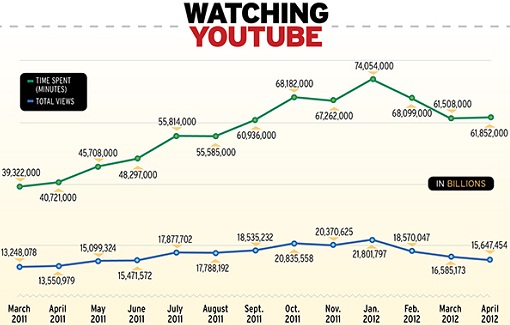 The best indicator for users to ponder on specific video success is its view count. Think about it, when you see that some video has 90 million views, you’ll probably value it as much better than other videos. This is also how YouTube ranked and recommended videos.
The best indicator for users to ponder on specific video success is its view count. Think about it, when you see that some video has 90 million views, you’ll probably value it as much better than other videos. This is also how YouTube ranked and recommended videos.
Apparently, those days are now gone. Goodbye view count, hello engagement.
As I already stated several times in the past, although YouTube is by far the most popular video site on the web it doesn’t really see other video sites as competitors. In the eyes of the fellows that runs YouTube (Google that is), the T.V. is the real rival of the site.
And to become a worthy T.V. substitute, much more videos on the site must be longer and more quality than the three-minutes “so cute dog and cat playing together” type of videos. Even more important, longer videos that attracts visitors to watch, means more possible ads to serve.
Therefore, the YouTube folks have changed the algorithmic methods they are rankings and recommending videos. The accentuation has been subtly moved from total view count towards level of engagement, the actual number of minutes users have watched a video.
Shifting users to longer more quality videos and increasing the time users are watching each video had to come on the expense of, oh yes, views. It appears that YouTube has been deliberately reducing the site’s video views, in order to raise time spent on each video.

In the chart above (compiled by comScore) we can see that on January YouTube reached a peak of 21.8 billion video views and 74.1 billion total minutes spent. That is an average of about 3.4 minutes viewed per video. Since then, there was a purposed drop in total views.
On April, total video views fell by nearly 30% to 15.6 billion and total minutes spent fell by 16.5% to 61.9 billion compared to January. However, average minutes viewed per video rose by more than 16% to 3.95. So yes, view count is down, but the level of engagement is way up.
Last month, Google opened up AdWords For Video to allure more businesses to advertise on YouTube inside the familiar interface of AdWords. Increasing the level of engagement towards longer videos is making it possible to display more ads on better quality videos.
Obviously now, content creators stands in front of a bigger more sophisticated challenge than before- Not just bringing people to click on a certain video link, but now also to keep them there watching as much of the video as possible. And from a visitor point of view, it seems like a good change.
Some video creators managed to manipulate their way to lots of video views by using misleading titles and deceiving thumbnails which resulted many clicks and consequently, better conspicuousness by YouTube’s algorithm. With the last few months’ changes, they’ll drop and more quality videos will surface.
When thinking about it, that’s kind of like the Panda update of YouTube…